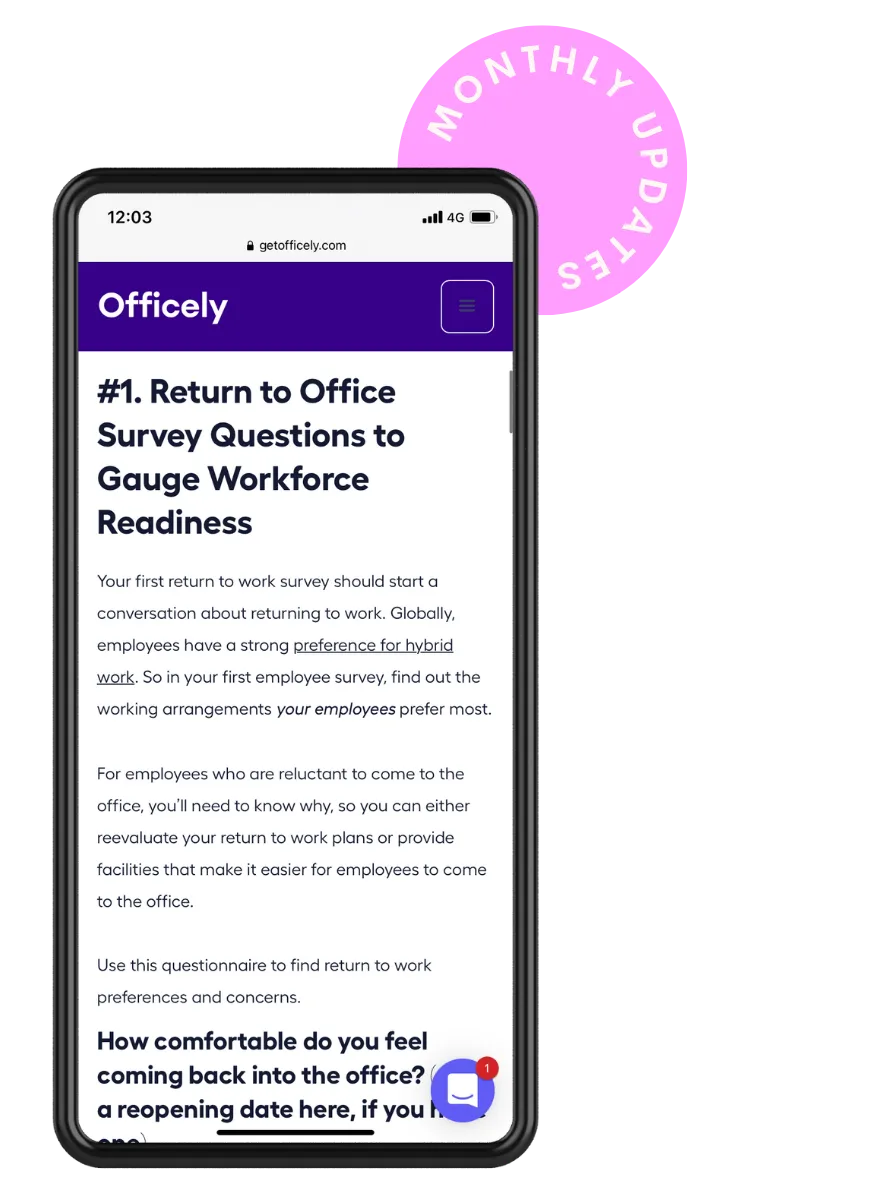Try Officely Today
See who's in the office, organize socials and events, and increase your office attendance all within Slack.
HYBRID OFFICE INSPO STRAIGHT TO YOUR INBOX
Get your monthly hit of insights and ideas sourced by the Officely team.
Join our webinar: How to Encourage Your
Employees Back to the Office
We walk through how you can encourage more of your team
to come back to the office with Officely.
Register NowHow to Incentivize Employees to Return to the Office
Encouraging your team to return to the office is the key to reviving office culture. Use our guide to learn the best practices to increase attendance.
Read More

During lockdown pretty much every office worker has had a taste of working from home. Some love it, others hate it.
Now, businesses have opted more for a hybrid work schedule, which includes a portion of the workweek to work from home. We’ve grouped together a list of the most common advantages and disadvantages of a work-from-home strategy so that you can decide what is best for your business.
Global Workplace Analytics conducted a study of over 4,000 reports to find the following benefits.
1. Improves employee satisfaction
- People are sick of the rat-race, eager to take control of their lives, and desperate to find a balance between work and life.
- As such, two-thirds of people want to work from home and 36% would choose it over a pay raise.
- In addition, a poll of 1,500 technology professionals revealed that 37% would take a pay cut of 10% if they could work from home.
- Gen Y’ers are more difficult to recruit (as reported by 56% of hiring managers) and to retain (as reported by 64% of hiring managers), but they are particularly attracted to flexible work arrangements (rating among benefits as an 8 on a 10 scale for impact on overall job satisfaction).
- 80% of employees consider working from home as a job perk.
2. Reduces employee turnover
- Losing employees can cost on average between $10,000 to $30,000 and recruiting and training a new hire can cost thousands.
– 14% of Americans have changed jobs to shorten the commute.
– 46% of companies that allow employees to work from home say it has reduced attrition.
– 95% of employers say working from home has a high impact on employee retention.
– Almost half of employees feel their commute is getting worse; 70% of them feel their employers should take the lead in helping them solve the problem.
– 92% of employees are concerned with the high cost of fuel and 80% of them specifically cite the cost of commuting to work. 73% feel their employers should take the lead in helping them reduce their commuting costs.
– Two-thirds of employees would take another job to ease the commute.
3. Reduces unscheduled absences
- It will come as no surprise that 78% of employees who call in sick, really aren’t! They do so because of family issues, personal needs, and stress.
- Unscheduled absences cost employers $1,800/employee/year; that adds up to $300 billion/year for U.S. companies.
- According to the American Management Association, organizations that implemented a work-from-home program, realized a 63% reduction in unscheduled absences.
- Work-from-homers typically continue to work when they’re sick (without infecting others).
- Work-from-homers return to work more quickly following surgery or medical issues.
- Flexible hours allow work-from-homers to run errands or schedule appointments without losing a full day.
4. Increases productivity
- Best Buy, British Telecom, Dow Chemical reported that employees that work from home are 35–40% more productive.
- It’s estimated that businesses lose $600 billion a year in workplace distractions.
- Over two-thirds of employers report increased productivity among their employees that work from home.
- Sun Microsystems’ estimated that their employees spend 60% of the commuting time they save performing work for the company.
- AT&T have reported that their employees work five more hours per week working from home compared to office-based workers.
- Whereas, JD Edwards has stated that work from homers are 20–25% more productive than their office counterparts.
- American Express believe their workers are 43% more productive and Compaq believe it’s 15–43%.
Try Officely Today
See who's in the office, organize socials and events, and increase your office attendance all within Slack.
HYBRID OFFICE INSPO STRAIGHT TO YOUR INBOX
Get your monthly hit of insights and ideas sourced by the Officely team.
Join our webinar: How to Encourage Your
Employees Back to the Office
We walk through how you can encourage more of your team
to come back to the office with Officely.
Register NowNew Office Management Handbook for Flexible Workplaces
Packed with actual experts insights and pro tips, this guide is here to help you find out all about managing a flexible office!
Send me the eBook nowHow to Incentivize Employees to Return to the Office
Encouraging your team to return to the office is the key to reviving office culture. Use our guide to learn the best practices to increase attendance.
Read More

5. Saves employers money
- Nearly 60% of employers identify cost savings as a significant benefit to offering employees the ability to work from home.
- Alpine Access Remote Agents home-based employees close 30% more sales, customer complaints decreased by 90% and turnover decreased by 88%.
- IBM slaved $50 million on real estate costs after implementing a work from home strategy.
- Sun Microsystems saves $68 million a year in real estate costs.
- McKesson has said it saves them$2 million a year.
- On average businesses save $10,000 a year per employee on real estate costs.
- It also offers inexpensive compliance with ADA for disabled workers.
6. Reduces the potential for discrimination
- Virtual hiring, as some all-virtual employers do, greatly reduces the potential for discrimination.
- It ensures that people are judged by what they do versus what they look like.
- Communication via email and instant messaging equalizes personalities. No longer is the loudest voice the one that’s heard.
7. Cuts down on wasted meetings
8. Increases employee empowerment
- Remote work forces people to be more independent and self-directed.
Try Officely Today
See who's in the office, organize socials and events, and increase your office attendance all within Slack.
HYBRID OFFICE INSPO STRAIGHT TO YOUR INBOX
Get your monthly hit of insights and ideas sourced by the Officely team.
Join our webinar: How to Encourage Your
Employees Back to the Office
We walk through how you can encourage more of your team
to come back to the office with Officely.
Register NowHow to Incentivize Employees to Return to the Office
Encouraging your team to return to the office is the key to reviving office culture. Use our guide to learn the best practices to increase attendance.
Read More

9. Increases collaboration
- Once telework technologies are in place, employees and contractors can work together without regard to logistics. This substantially increases collaboration options.
10. Provides new employment opportunities for the un- and under-employed
- Eighteen million Americans with some college education aren’t working.
- More than 12% of the working-age population are disabled (16 million). A full three-quarters of unemployed workers with disabilities cite discrimination in the workplace and lack of transportation as major factors that prevent them from working.
- 24 million Americans work part-time.
- Only 75% of women, still the traditional primary caregivers age twenty-five to fifty-four, participate in the labor force (compared to 90% of men). Almost a quarter of women work part-time (16.5 million), compared to 10% of men.
11. Expands the talent pool
- Working from home reduces geographic boundaries, massively increasing the talent pool.
- Provides access to disabled workers and employees from different areas.
- Offers an alternative that would have otherwise kept parents and senior caregivers out of the workforce.
- Offers geographic, socioeconomic, and cultural diversity that would not otherwise be possible.
12. Slows the brain-drain due to retiring Boomers
- 75% of retirees want to continue to work — but they want the flexibility to enjoy their retirement.
- 36% of retirees say the ability to work part-time rather than full-time, or to work from home would have encouraged them to keep working — even if it didn’t provide health benefits or meant a temporarily reduced pension.
- 38% of surveyed retirees indicated that being able to work seasonally or on an independent contractor basis would have encouraged them to delay retirement.
- 71% of retired workers who later decided to go back to work, originally retired because of a desire for more flexibility than their job offered.
Try Officely Today
See who's in the office, organize socials and events, and increase your office attendance all within Slack.
HYBRID OFFICE INSPO STRAIGHT TO YOUR INBOX
Get your monthly hit of insights and ideas sourced by the Officely team.
Join our webinar: How to Encourage Your
Employees Back to the Office
We walk through how you can encourage more of your team
to come back to the office with Officely.
Register NowHow to Incentivize Employees to Return to the Office
Encouraging your team to return to the office is the key to reviving office culture. Use our guide to learn the best practices to increase attendance.
Read More

13. Reduces staffing redundancies and offers quick scale-up and scale-down options
- Having access to a flexible at-home workforce allows call centers, airlines, and others to add and reduce staff quickly as needed.
- The need to overstaff ‘just in case’ is greatly reduced.
- 24/7 worldwide coverage is easier to staff with home-based help.
14. Environmentally-friendly policies are good for companies
- Sun Microsystems reported that its 24,000 U.S. employees participating in the Open Work Program avoided producing 32,000 metric tons of CO2 last year by driving less often to and from work.
- Office equipment energy consumption rate is twice that of home office equipment energy consumption.
- 70% of employees report they would see their companies in a more favorable light if they helped them reduce their carbon emissions.
- 24% of employees say they’d take a pay cut of up to 10% to help the environment.
15. Reduces traffic jams
- If traffic continues to grow at the current pace, over the next couple of decades drivers in Atlanta, Baltimore, Chicago, Denver, Las Vegas, Miami, Minneapolis/St. Paul, Portland, San Francisco-Oakland, Seattle-Tacoma, and Washington, D.C. will be sitting in daily traffic jams worse than the infamous traffic jams that plague Los Angeles eight hours a day.
- As a result, commutes will take almost twice as long and you’ll have to leave even earlier to allow for traffic jams if you have to arrive someplace at a specific time, producing a further reduction to our national productivity.
- Traffic jams rob the U.S. economy of $78 billion/year in productivity.
- Traffic jams idle away almost three billion gallons of gas and accounts for 26 million extra tons of greenhouse gases.
- Every 1% reduction in vehicles yields a three-fold decrease in congestion.
16. Ensures continuity of operations in the event of a disaster
- As has been seen in the recent COVID-19 pandemic, having a work from home ready workforce means you can continue uninterrupted.
Try Officely Today
See who's in the office, organize socials and events, and increase your office attendance all within Slack.
HYBRID OFFICE INSPO STRAIGHT TO YOUR INBOX
Get your monthly hit of insights and ideas sourced by the Officely team.
Join our webinar: How to Encourage Your
Employees Back to the Office
We walk through how you can encourage more of your team
to come back to the office with Officely.
Register NowHow to Incentivize Employees to Return to the Office
Encouraging your team to return to the office is the key to reviving office culture. Use our guide to learn the best practices to increase attendance.
Read More

The drawbacks of Working from Home
Management mistrust
- 33% of managers reported that they trust their employees more when they can see them.
Collaboration concerns
- Some managers feel that distance inhibits collaboration. They need the ‘energy in the room’ when a crisis occurs.
- When working from home you loose the “water-cooler moments” where employees strike up a conversation that leads to new ideas and strategies.
It’s not for everyone
- Social needs must be addressed. Some can work from home very well, but others can feel isolated and lonely.
Career fears from ‘out of sight, out of mind’ mentality
- Some employees cite career fears as a reason not to want to work from home. Successful working from home programs overcome the ‘out of sight, out of mind’ issue with performance-based measurement systems, productivity versus presenteeism attitudes.
Security issues
- Managers worry about the security risk of employees accessing files remotely.
- However, if you ask those actually in charge of security of large organisations, 90% feel that home-based workers are not a security concern. In fact, they are more concerned with the occasional work that is taken out of the office by traditional employees who lack the training, tools, and technologies that work from homers receive.
IT infrastructure changes may be necessary
- Employees working from home need access to company systems, software, and data.
- Infrastructure changes that support work from home might be needed.
- Companies need to address remote technical support issues. Off-the-shelf solutions exist.
Try Officely Today
See who's in the office, organize socials and events, and increase your office attendance all within Slack.
HYBRID OFFICE INSPO STRAIGHT TO YOUR INBOX
Get your monthly hit of insights and ideas sourced by the Officely team.
Join our webinar: How to Encourage Your
Employees Back to the Office
We walk through how you can encourage more of your team
to come back to the office with Officely.
Register NowHow to Incentivize Employees to Return to the Office
Encouraging your team to return to the office is the key to reviving office culture. Use our guide to learn the best practices to increase attendance.
Read More

Summary
Working from home clearly has a lot of benefits for both employee and employer, ranging from better work life balance to huge cost savings. However what are the drawbacks? Read on here for both sides of the story.
Try Officely Today
See who's in the office, organize socials and events, and increase your office attendance all within Slack.
HYBRID OFFICE INSPO STRAIGHT TO YOUR INBOX
Get your monthly hit of insights and ideas sourced by the Officely team.
Join our webinar: How to Encourage Your
Employees Back to the Office
We walk through how you can encourage more of your team
to come back to the office with Officely.
Register NowHow to Incentivize Employees to Return to the Office
Encouraging your team to return to the office is the key to reviving office culture. Use our guide to learn the best practices to increase attendance.
Read More

Try Officely Today
See who's in the office, organize socials and events, and increase your office attendance all within Slack.
HYBRID OFFICE INSPO STRAIGHT TO YOUR INBOX
Get your monthly hit of insights and ideas sourced by the Officely team.
Join our webinar: How to Encourage Your
Employees Back to the Office
We walk through how you can encourage more of your team
to come back to the office with Officely.
Register NowHow to Incentivize Employees to Return to the Office
Encouraging your team to return to the office is the key to reviving office culture. Use our guide to learn the best practices to increase attendance.
Read More

HYBRID OFFICE INSPO STRAIGHT TO YOUR INBOX
Get your monthly hit of insights and ideas sourced by the Officely team.
Join our webinar: How to Encourage Your
Employees Back to the Office
We walk through how you can encourage more of your team
to come back to the office with Officely.
Register NowTry Officely Today
See who's in the office, organize socials and events, and increase your office attendance all within Slack.









%20(2).gif)






.svg)